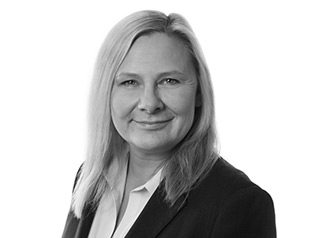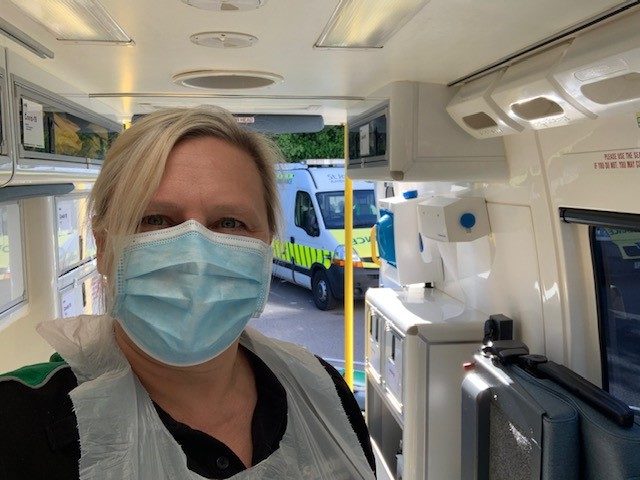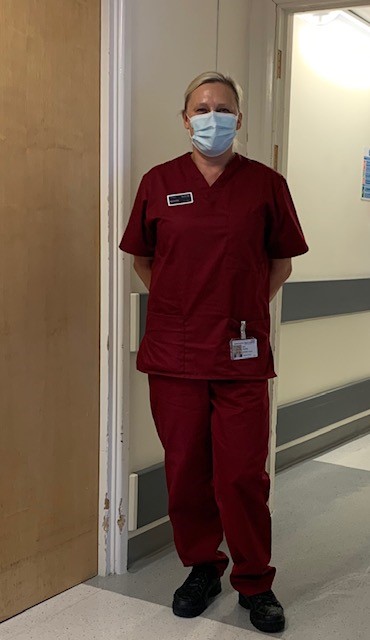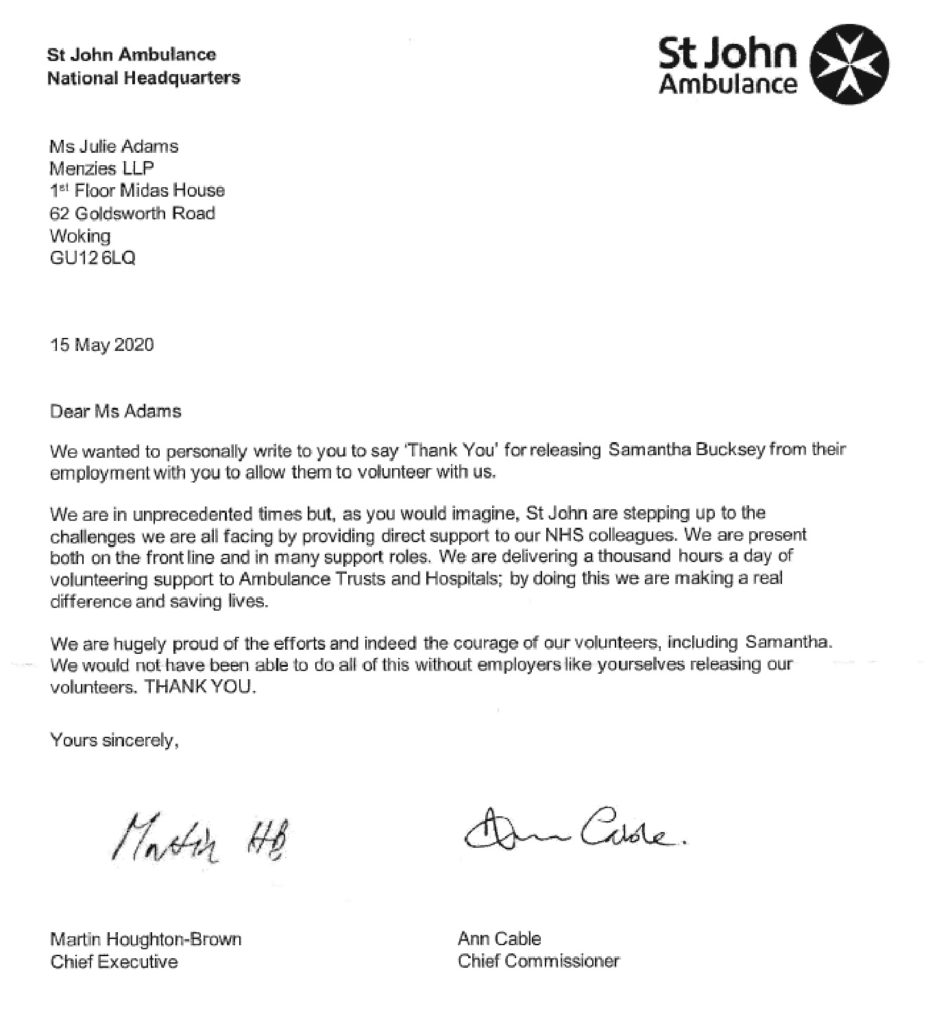
Sam Bucksey – Audit Manager
When it became clear how significantly the pandemic would hit the UK, Samantha Bucksey, a manager in the Heathrow Audit team, asked us if she could respond to the calls for help. We were delighted to release her, on full pay, for a month and when she returned at the start of June, we caught up with her to find out how she had got on.
How did you become involved as a volunteer?
I have been a St John Ambulance First Aid volunteer for the last 6 years and belong to the Weybridge Unit. When the coronavirus pandemic was declared I volunteered to go to the NHS Nightingale in London. I applied to Menzies for 4 weeks volunteer leave so that I could assist my St John colleagues to support the NHS.
Did you require additional training?
Yes, and I began my additional COVID-19 training in late March/early April. This consisted of a series of online courses and then a weekend classroom course. I also qualified as a Loggist to assist in an Administrative role at the Joint Operations Control Centre in Central London. In April, while I was still working at Menzies, I was included in all operational notifications relating to the Nightingale and was due to be deployed there in May.
Did you end up at the Nightingale Hospital?
As the London Hospitals were, in the main, able to cope with the COVID-19 patients, the NHS Nightingale London received only a fraction of the patients they had been prepared to take and as such the Nightingale London was put into hibernation at the beginning of May. Accordingly, my volunteering deployment was changed. Initially, I was deployed to the Logistics team at the Guildford Ambulance Hub and then, later, at St Peters Hospital in Chertsey.
What did you do at the Ambulance Hub?
On my first day I was met by Dan, a friendly and welcoming face, together with a number of other volunteers. It was our job to clean the inside of the ambulances from ceiling to floor, and audit and replenish the stock. I was provided with Personal Protective Equipment (PPE) which had to be worn and changed in between every task to avoid cross contamination – mask, aprons and gloves. After the first few minutes of wearing a mask I had a headache!
At first it was quite hard and took a long time to audit every single stock item on the ambulances. We had detailed lists that were regularly updated as requirements changed. The ambulance crews we were supporting were also volunteers. They were most often deployed from the Guildford Hub to support the London Ambulance Service.
Did your role change at the Hub?

Yes. While I was there, I completed the online training modules for Logistics and I was trained to be a Hub Commander. This was very exciting and I really enjoyed it. The Hub Commanders role includes attending a Regional call first thing with all of the other districts. This is used to pass on messages from Regional control and an opportunity to provide feedback.
Then it is time to get everything ready for the crews when they arrive – what ambulance they have been allocated, the radio, the monitor and their paperwork for that shift.
After that it is over to the Crew Room to brief the crew. Once the crews have deployed, the Hub Commander is on call to assist the crews, if required.
On their return, the crews are met at the Hub where they hand in paperwork, radios, keys etc and advise of any issues with the ambulances, which are noted and addressed as soon as possible.
So, after the Hub, it was straight over to St Peters?
Almost! Each hospital Trust has its own policies and whilst I had undertaken the St John Ambulance COVID-19 training, I had to attend a full day of training before I could volunteer on one of the wards.
We covered what our role was going to be within the hospital, how to look after our own health & well being, resilience training, GDPR, electronic observations equipment and practical skills. I was really happy to show off my hospital corner skills that I learnt about 40 years ago in the Brownies!
What did a typical day at the Hospital look like?
5.45am – wake up
6.45am – travel to the hospital
7.15am – arrive and be ready for handover meeting
8am to 8pm – Look after patients, ensure that they are all washed, beds changed, observations, done, help with meal times- breakfast, lunch and dinner, complete charts for each patient as required, answer all patient call bells, and then get patients ready for bed.
Morning break (15 minutes) and lunch (1 hour) were decided by the Staff nurse in the morning.
8pm – leave hospital after getting changed out of scrubs
8.30pm – arrive home and put scrubs straight in to wash at 60 degrees and spray shoes with disinfectant. Then it was off to the shower before thinking about dinner.
What did you have to wear on the Wards?
I was dressed in maroon coloured scrubs and black washable footwear. It was decided that our St John Ambulance Service Delivery uniform was too hot to wear on hospital wards as it was designed for outdoor duties. PPE is very strict in the wards. A mask is worn at all times and changed every two hours. Apron and gloves must be worn and changed between each patient with hands being thoroughly washed each time. One patient did make me laugh one day when she asked me why I wore shiny make-up – I was actually just melting!!!
Where did you work inside the Hospital?
Ashford & St Peters Hospital Trust have decided that volunteers will not be asked to work on the COVID wards because they are volunteers and not paid staff. This did not mean that we would not be in contact with the odd one or two patients that initially tested negative and later tested positive and are then re-located to a COVID ward. The wards I worked on had a mixture of different types of patients, both medical and surgical, which made it more interesting.
What sort of work were you doing on the wards?
During my first shift I encountered death, diarrhoea and dementia. These were all things that I had trained for but different when there are real people involved.
Every minute was filled – helping patients eat their meals, washing those who couldn’t manage on their own, taking observations, changing beds, just talking to patients as they could have no visitors, brushing teeth, applying creams – the list was endless. Teamwork was definitely the key: if someone needs help with a patient there is always someone there to help. The staff are supportive of each other and are always checking to see that each other are okay, especially after any difficult situation.

It certainly sounds like an intense and tiring period
At the end of my time volunteering I was indeed tired. I also had pressure sores on the tops of my ears and sore eyes from wearing masks, and broken skin on my hands. I had no idea how hard the staff have to work to ensure that all of the patients received the care and attention that they need whilst they are in hospital. It was definitely hard seeing patients that may be upset, poorly, lonely and confused. I couldn’t make their illness / injuries go away but I was able to talk to them, reassure them and hopefully make them feel a little bit better.
I understand that your team at Menzies weren’t far from your thoughts?
That is correct, I did think about them a lot whilst I was away. As everyone needs encouragement sometimes I just arranged for a couple of small gifts to be sent to everyone on one of my days off. I hope it helped to put a smile on their faces at a challenging time.
What would you say you have learnt from your experience?
I learnt an awful lot during this month, including the absolute importance of communication, on all levels, the importance of looking after each other, the importance of making the most of every day, (you just don’t know what is round the corner), the importance of being kind, and caring about how people are feeling.
Also, ‘it is not someone else’s problem’. If you see or know something is not right, it is your duty to do what you can to address this. Even if you need to think of a solution and then pass that idea on to someone who can action it.
One last point that I learnt was the importance of looking after yourself – you are no use to anyone else if you have nothing left inside of yourself.
From all of us, a huge “Thank You Sam” for stepping up when you were needed!
